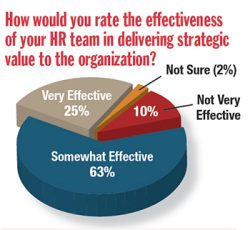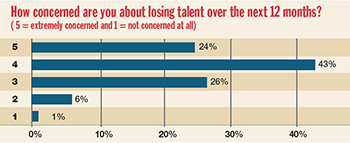Employee engagement continues to reign supreme as the top HR worry in HRE’s 2018 What’s Keeping HR Up at Night survey, but just by a hair.
The survey of 314 HR executives, conducted in January, found that nearly 29 percent of respondents ranked engagement as their No. 1 concern, compared to 32 percent a year earlier. 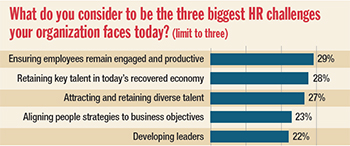 But it’s worth noting that its lead tightened significantly from the previous year, with two other concerns currently right on its tail: retaining key talent in a recovered economy (28 percent) and attracting and retaining diverse talent (27 percent).
But it’s worth noting that its lead tightened significantly from the previous year, with two other concerns currently right on its tail: retaining key talent in a recovered economy (28 percent) and attracting and retaining diverse talent (27 percent).
Stress levels, meanwhile, climbed slightly from the year before, with roughly 73 percent of the respondents reporting that their stress levels increased either somewhat or dramatically over the past 18 months, compared with 72 percent a year earlier.
As to what issues they would like to see at the top of the nation’s legislative agenda, respondents cited healthcare (71 percent), immigration reform (33 percent) and job creation (27 percent). Wage and hour (24 percent) moved from the second spot in 2017 at 37 percent to the fourth spot in 2018 at 25 percent.
Respondents were fairly evenly split regarding whether their departments are properly staffed to handle the workload: 49 percent said they are appropriately staffed, while 45 percent reported being inadequately staffed. Topping the list of understaffed disciplines were training and development (43 percent), recruiting (43 percent) and HR metrics/analytics (34 percent). The same three were cited in this exact order a year earlier.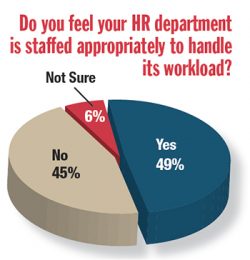
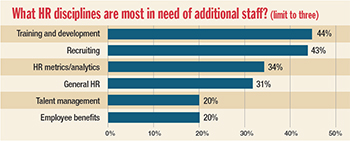 The 2018 survey also once again confirmed a well-known shortcoming that plagues the profession: Most HR leaders aren’t leading by example as far as succession planning is concerned. Indeed, six in 10 respondents (60 percent) said their companies do not have HR succession plans in place.
The 2018 survey also once again confirmed a well-known shortcoming that plagues the profession: Most HR leaders aren’t leading by example as far as succession planning is concerned. Indeed, six in 10 respondents (60 percent) said their companies do not have HR succession plans in place.
A lack of succession planning is all too common in HR, says Joe Ungemah, North America practice leader for talent management and organizational alignment at Willis Towers Watson. He notes that it’s often more attractive to “buy” HR talent from the outside than to build talent from within because many of the required skills are easily transferable. This practice, however, is risky, he adds, because it can present a supply-and-demand issue–supply for talent isn’t keeping pace with the demand in HR-leadership job vacancies.
Ungemah says that succession planning especially makes sense when the HR and business strategies are closely aligned and, therefore, would be difficult to replicate. It also needs to be a priority, he says, in situations in which talent demand exceeds supply, such as at organizations that are experiencing rapid growth or facing a tight labor market.
Similar to a year earlier, most respondents (83 percent) in the recent study don’t expect to implement changes to their retirement plans in the coming year. Among those who do plan to make changes, the to-do list includes offering additional consulting/retirement-planning services (61 percent), followed by adding 401(k) automatic enrollments and increasing 401(k) matching (both at 32 percent).
All of the respondents in the survey predict that at least some portion of their baby boomers will retire in the next 12 months, with roughly four in 10 expecting 4 percent or more of their workforce will retire during that period.
Investing in the financial well-being of employees enables them to retire when they want to, he adds.

